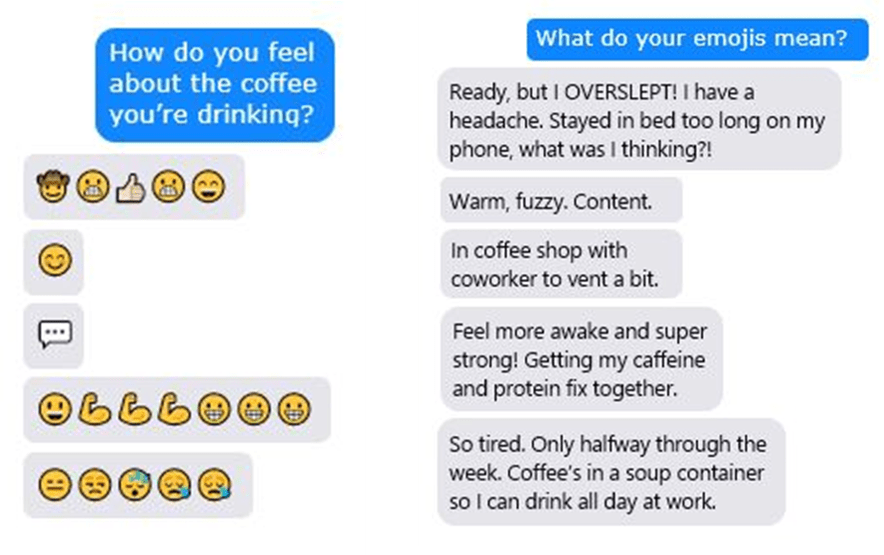
*Note: original text has been paraphrased to protect privacy.
These are just a few of the answers we collected in a mobile ethnography study exploring coffee purchasing journeys.
The wide variety of different emojis is telling – coffee means very different things to different people, and so they buy it with different purposes in mind.
The answers to the second question (on the left) tell us a little more about what those purposes are. From those, we see that coffee is a way to start the day, to relax, to connect with others, to feel healthy and strong, or just to push through the workweek.
We could simply have asked respondents to answer through text. However, the emojis we collect is not the point of the exercise. The point of the exercise is to engage respondents and encourage them to draw on a broad lexicon of culturally significant signs and symbols to express themselves. Or, in other words, emojis serve as a way of encouraging respondents to be creative in their responses and convey deeper meaning without overthinking it.
Some respondents have been more receptive to the use of emojis than others. Discomfort or lack of familiarity with emojis tends to arise most commonly from older respondents.
However, age does not automatically determine whether someone is familiar or unfamiliar with the lexicon of popular culture. Many older respondents are quite comfortable using emojis, or at least find themselves capable of adopting emojis for the purposes of a study. Some – old or young – might not be familiar with the meaning popularly attached to certain emojis, but text answers allow us to understand what respondents think those symbols mean.
Popular interpretations of emojis are useful to know, but usually not enough to accurately interpret emojis. People use emojis to construct and convey personal meaning. Thus, contextualizing emojis is crucial, both when using them and interpreting them.*
Emojis in Market Research
For instance, in a mobile ethnography study exploring employee experiences in a large organization, MDRG asked consumers to use emojis to represent how they felt about their experiences in the workplace. One respondent offered the following answer:

When first asked about their experiences in preliminary interviews, respondents were hesitant to say anything critical or negative about their work environment. After the initial interviews, they were asked to use more creative forms of expression like emojis or drawings and began sharing more about their negative experiences and challenges than they had in the interviews.
These respondents undoubtedly became more comfortable sharing their opinions as they became habituated to the researchers and the study. However, emojis were part of what engendered greater comfort and familiarity. They also provided respondents with a tool to think creatively about their experiences and to better express their feelings and thoughts.
The vampire emoji serves as a representation of feelings respondents found hard to convey, but managed, ultimately through a combination of emojis, drawings, and images. Through that material, we understood that employees were feeling alienated from their work environments and from their employer. MDRG recommended improving employee engagement by improving communication at targeted pain points and providing employees with opportunities to feel a greater sense of agency and empowerment.
Some respondents will doubtlessly feel more comfortable than others using emojis. Regardless, for researchers, emojis can improve engagement with respondents and can provoke thoughtful and creative answers to provide deeper insights.
*To ensure respondents understand instructions and questions, emojis should always be used carefully by the researcher and given enough contextualization to ensure that all respondents understand the meaning.
Are you eager to stay ahead of the curve in your industry? Sign up for our monthly insights email and gain exclusive access to valuable market research, industry trends, and actionable recommendations delivered directly to your inbox.
Topics from this blog: Qualitative Research